More than 12,000 families across Arizona, Florida, Mississippi, and Tennessee, are using education savings accounts (ESAs) to pay for personal tutors, education therapists, private school tuition, and textbooks, to name a few possible uses. Lawmakers in Nevada and North Carolina have enacted similar laws.[REF] With an account, a family removes the child from an assigned public school, and the state deposits a portion of a child’s funds from the state formula into a private account that parents use to buy educational products and services for that child. Families can use an account to find a new school or even customize a child’s education according to individual needs.
This year, Congress is considering a proposal to allow children in active-duty military families across the country the option to use ESAs. Washington provides taxpayer funding to military-connected families for education purposes through a federal program called Impact Aid. The federal government provides school districts with Impact Aid funding in addition to the other revenue that the districts receive from state, local, and federal sources for education purposes.[REF] Under the proposal, officials would deposit a portion of a military-connected child’s Impact Aid funding into an ESA account, and families could customize their child’s education according to her needs.
Educational Options for Families
The accounts offer families more learning options than K–12 private school scholarships or vouchers, as evidenced by the way account laws are designed, how families use the accounts, and by state supreme court rulings that distinguish the accounts from scholarships.
Families can use an account to pay for multiple learning experiences simultaneously, including the hiring of personal tutors, paying for education therapies for children with special needs, and saving account funds from year to year.[REF] While K–12 private school scholarships and vouchers—as exist in Wisconsin, Ohio, and Florida—help families to choose a new school for their child, the accounts allow families to customize their child’s education and purchase more than one education product or service.
Research demonstrates that families are, in fact, using the accounts for more than just private school tuition. In Florida, 40 percent of account holders use their child’s accounts to purchase multiple learning experiences simultaneously.[REF] In Arizona, one-third of account holders do so.[REF]
Furthermore, the Arizona Supreme Court and the Nevada Supreme Court have issued opinions upholding the difference between ESAs and scholarships.[REF] Arizona Appeals Court Judge John W. Thompson wrote an opinion the state supreme court upheld and said,
Where [ESA] funds are spent depends solely upon how parents choose to educate their children. Eligible school children may choose to remain in public school, attend a religious school, or a nonreligious private school. They may also use the funds for educational therapies, tutoring services, online learning programs and other curricula, or even at a postsecondary institution…. Thus, beneficiaries have discretion as to how to spend the ESA funds without having to spend any of the aid at private or sectarian schools.[REF]
Both legally and practically, ESAs differ from private school vouchers.
Fiscal Impact on District Schools
Education savings accounts do not prevent traditional public schools from educating students who do not use an account and remain in a public school. Again, students are not required to use an account. Children who are succeeding in a traditional school setting can continue to do so.
The participation rates in states that have made accounts available to families are modest. In Arizona, 1.4 percent of eligible students are using an account instead of attending a public school.[REF] Similar figures are found in Florida (2.8 percent of eligible students).[REF] Even fewer students are using the accounts as a percentage of the public school population in Mississippi and Tennessee, though the number of accounts awarded in Mississippi is limited by statute, and Tennessee officials only launched the accounts last year.[REF]
Using data that the National Association of Federally Impacted Schools collected from the U.S. Department of Education, this brief drew a random sample of 296 public school districts that receive Impact Aid funding (of 1,157 districts in the data set that receive such funding).[REF] The Heritage Foundation estimated the fiscal impact on districts as a share of the district budget if 1 percent, 5 percent, or 10 percent of children currently enrolled in a school in a district on this list instead chose to use an ESA. While the participation figures in states that offer such accounts are below 5 percent, these rates are likely not consistent across school districts. For this reason, Heritage used larger participation rates (more than three times larger than Florida’s participation rate) in its estimates to consider several possibilities.
According to these data, districts would see changes to their Impact Aid funding as a total share of the district’s expenditures of no more than 0.10 percent. For heavily impacted districts—districts that have a significant number of students receiving Impact Aid—the figures are similar.[REF] (See Table 1.) Only four heavily impacted districts would see expenditures change by more than 5 percent.
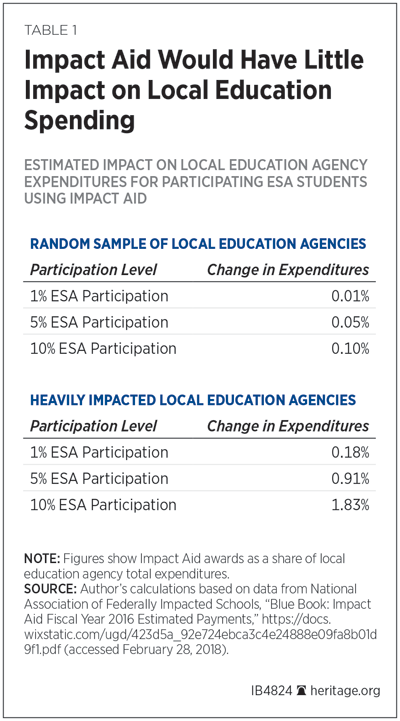
In the random sample, the change to total Impact Aid funding as a share of total district expenditures is 0.1 percent or less in every instance (1 percent, 5 percent, and 10 percent student participation).[REF] For heavily impacted districts, the total change to Impact Aid funding as a share of total district budget expenditures is less than 2 percent.
Conclusion
Education savings accounts have been life-changing for more than 12,000 children across the country. Furthermore, estimates on the fiscal impact for school districts that receive Impact Aid indicate a small budgetary change in terms of Impact Aid appropriations. These estimates include student participation levels that are larger than current state participation rates.
For schools, this change in Impact Aid funding is one that institutions may deal with regularly when students transfer out for other reasons—such as when military families change duty stations. Yet for participating families, education savings accounts can change the course of a child’s life and give him or her opportunities for a bright future.
—Jonathan Butcher is Senior Policy Analyst in the Center for Education Policy, of the Institute for Family, Community, and Opportunity, at The Heritage Foundation.
Appendix: Methods and Interpreting the Findings
(Appendix added on March 9, 2018.)
Methods
For this analysis, Heritage used the National Association of Federally Impacted Schools’ “Blue Book: Impact Aid Fiscal Year 2016 Estimated Payments.”[REF] These data provide information on the federal Impact Aid payments to school districts around the country. The Blue Book also provides the total number of students in each district, and the number of students in each district who generate Impact Aid (children of uniformed service personnel who live on a military installation, as well as those who live off-base in a heavily impacted district; Native American students; children living in federal low-rent housing; and children from civilian families who live or work on federal property).
Using these figures, Heritage calculated the average Impact Aid award per child. For example, see Appendix Table 1.
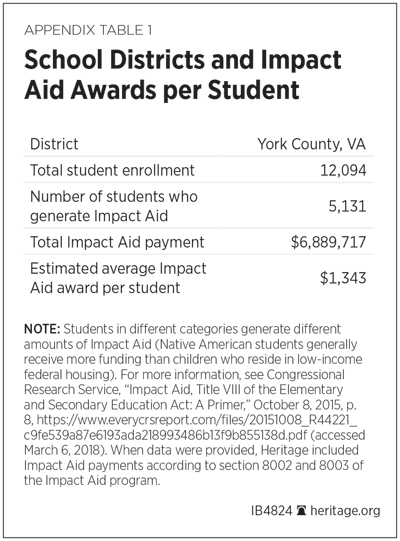
Once the average award per child is calculated, one can calculate the amount of Impact Aid that a district would no longer receive if 1 percent of the students in the district chose to use an ESA instead of attending that district school. Appendix Table 2 provides an example.
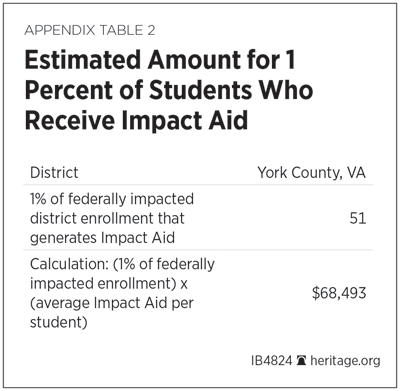
Next, Heritage used the National Center for Education Statistics’ Common Core of Data to find the total expenditures for each district.
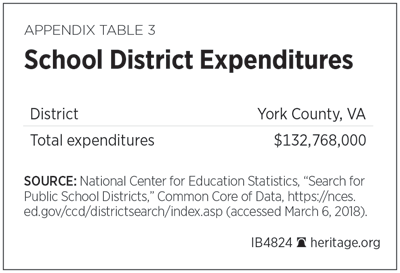
The total district expenditure figure is larger than the Impact Aid appropriation because districts receive funding from the state general fund, local tax sources, and other federal sources. Thus, Impact Aid is one part of a district’s funding formula.
Once the figures from Appendix Tables 1, 2, and 3 are entered, one can calculate the percentage of a district’s total expenditures that would be affected if 1 percent of the students who receive Impact Aid chose to use an ESA instead of attending a district school.
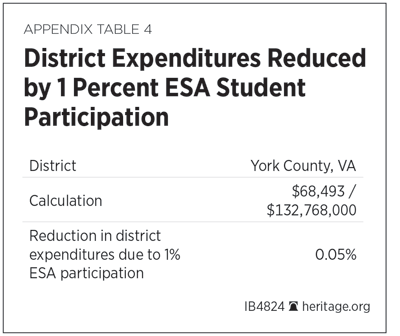
Appendix Table 4 demonstrates that if 1 percent of the students who generate Impact Aid in York County, Virginia, chose to use an ESA, the reduction to that district’s Impact Aid funding as a share of total district expenditures would be 0.05 percent. Heritage repeated these calculations to estimate the reduction if 5 percent and 10 percent of students used ESAs.
In this Issue Brief, the average Impact Aid awards per 1 percent, 5 percent, and 10 percent of students were totaled for the random sample and the list of “heavily impacted” districts and divided by the sum of district expenditures from each district. These results are provided in Table 1 of the main text.
Interpreting the Findings
As this Issue Brief explains, Heritage estimated the change to a district’s Impact Aid funding according to ESA participation rates similar to, and even greater than, participation rates in the two states with the largest enrollment of ESA students—Arizona and Florida.
The implication of these findings is that Impact Aid accounts for a modest portion of school district budgets. When a student who generates Impact Aid leaves a district to use an ESA, the change in Impact Aid as a share of total district expenditures is also modest.



